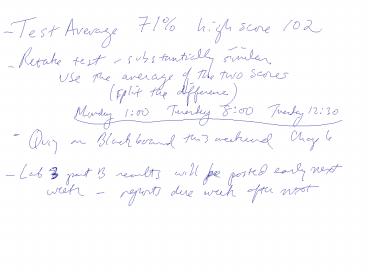Bond Making and Bond Breaking - PowerPoint PPT Presentation
1 / 16
Title:
Bond Making and Bond Breaking
Description:
Predictions of Collision Theory. A rate equation contains concentration terms for all reactants in a one-step mechanism. Collision theory requires this. ... – PowerPoint PPT presentation
Number of Views:117
Avg rating:3.0/5.0
Title: Bond Making and Bond Breaking
1
(No Transcript)
2
Bond Making and Bond Breaking
3
Common Reactive Intermediates
Bond Making and Bond Breaking
- Radicals and carbocations are electrophiles
because they contain an electron deficient
carbon. - Carbanions are nucleophiles because they contain
a carbon with a lone pair.
4
Energy Diagrams
- For the general reaction
- The energy diagram would be shown as
5
Activation Energy
- The activation energy is the minimum amount of
energy a collision of the reactants must supply
in order to react. - The larger the Ea, the greater the amount of
energy that is needed for a reaction to occur,
and the slower the reaction rate. - The structure of the transition state is
somewhere between the structures of the starting
material and product. - Transition states are drawn in brackets, with a
superscript double dagger ().
6
Drawing a Transition State
7
Equilibrium vs Rate
8
Stepwise Reactions
- Consider the following two step reaction
- An energy diagram must be drawn for each step.
- The two energy diagrams must then be combined to
form an energy diagram for the overall two-step
reaction. - Each step has its own energy barrier, with a
transition state at the energy maximum.
9
Step 1 Energy Diagram
10
Step 2 Energy Diagram
11
Overall Energy Diagram
12
Kinetics
- Kinetics is the study of reaction rates,
specifically the effect of reactant
concentrations on rate. - Temperature, Ea, reactant structure, and
catalysts all also can affect reaction rates. - Collision theory provides an explanation for
these effects.
Rate collision frequency x orientation factor x
energy factor
13
Predictions of Collision Theory
- For an elementary reaction, the higher the
concentration of the reactants, the faster the
rate. - The higher the temperature, the faster the rate.
- The lower the Ea the faster the reaction.
- A rate law or rate equation shows the
relationship between the reaction rate and the
concentrations of the reactants. It is
experimentally determined.
14
Kinetics and Mechanism
- A rate equation contains concentration terms for
all reactants in a one-step mechanism. Collision
theory requires this. - A rate equation contains concentration terms for
only the reactants in the rate-determining step
of a multi-step reaction.
15
Catalysts
- Some reactions do not proceed at a reasonable
rate unless a catalyst is added. - A catalyst is a substance that speeds up the rate
of a reaction. It is recovered unchanged in a
reaction, and it does not appear in the product.
16
Enzymes
- Enzymes are biochemical catalysts composed of
amino acids held together in a very specific
three-dimensional shape. - An enzyme contains a region called its active
site which binds an organic reactant, called a
substrate. The resulting unit is called the
enzyme-substrate complex. - Once bound, the organic substrate undergoes a
very specific reaction at an enhanced rate. The
products are then released.































